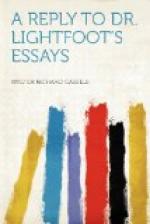of Jesuitism or of Wesleyanism—this
document contains nothing which ought to excite
a suspicion as to its authenticity.
“The one miraculous incident, which creates a real difficulty, is the dove issuing from the wounded side of the martyr. Yet even this might be accounted for by an illusion, and under any circumstances it would be quite inadequate to condemn the document as a forgery. But it will be shown hereafter (p. 627) that there are excellent reasons for regarding the incident as a later interpolation, which had no place in the original document. Beyond this we have the voice from heaven calling to Polycarp in the stadium to play the man (Sec. 9). But the very simplicity of the narrative here disarms criticism. The brethren present heard the voice, but no one saw the speaker. This was the sole ground for the belief that it was not a human utterance. Again, there is the arching of the fire round the martyr like a sail swelled by the wind (Sec. 15). But this may be explained as a strictly natural occurrence, and similar phenomena have been witnessed more than once on like occasions, notably at the martyrdoms of Savonarola and of Hooper. Again, there is the sweet scent, as of incense, issuing from the burning pyre (Sec. 15); but this phenomenon also, however we may explain it, whether from the fragrance of the wood or in some other way, meets us constantly. In another early record of martyrdoms, the history of the persecutions at Vienne and Lyons, a little more than twenty years later, we are told (Euseb. H.E. v. 1, Sec. 35) that the heroic martyrs, as they stepped forward to meet their fate, were ’fragrant with the sweet odour of Christ, so that some persons even supposed that they had been anointed with material ointment’ ([Greek: hoste enious doxai kai muro kosmiko kechristhai autous]). Yet there was no pyre and no burning wood here, so that the imagination of the bystanders must have supplied the incident. Indeed, this account of the Gallican martyrs, indisputably written by eye-witnesses, contains many more startling occurrences than the record of Polycarp’s fate.
“More or less closely connected with the miraculous element is the prophetic insight attributed to Polycarp. But what does this amount to? It is stated indeed that ’every word which he uttered was accomplished and will be accomplished’ (Sec. 16). But the future tense, ‘will be accomplished,’ is itself the expression of a belief, not the statement of a fact. We may, indeed, accept this qualification as clear testimony that, when the narrative was written, many of his forebodings and predictions had not been fulfilled. The only example of a prediction actually given in the narrative is the dream of his burning pillow, which suggested to him that he would undergo martyrdom by fire. But what more natural than this presentiment, when persecution was raging around him and fire was a common instrument of death? I need




